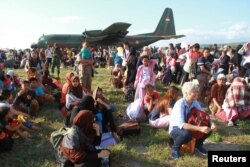Indonesia's President Jokowi Widodo has authorized the acceptance of international help related to the earthquake and tsunami that hit the central island of Sulawesi.
Chair of Indonesia's Investment Coordinating Board Thomas Lembong made the announcement in a tweet Monday morning.
There were 844 confirmed deaths by early Monday, with the city of Palu on Sulawesi the hardest hit.
Indonesian officials say they fear the death toll from Friday's earthquake and tsunami could soar into the thousands when rescuers are able to get to remote areas.
WATCH: Indonesia quake
The airport is barely functioning, most power plants have been knocked off-line, and roads are shattered and twisted.
Touring Palu Sunday, Indonesian President Joko Widodo said one of the immediate needs is to bring in the heavy equipment needed to move large pieces of rubble.
"We didn't expect it to be like this. So we hope and pray for the communities and be patient," he told disaster victims. "We know that there are a lot of things to do urgently, but the condition is not now possible."
He told soldiers deployed to the area to be ready to work nonstop.
Television pictures from Palu show buildings, cars and trees pushed together to form mounds of wreckage.
A young woman was pulled out alive from the rubble of Palu's collapsed Roa Roa Hotel. But rescuers say the number of other voices crying for help gradually dwindled throughout Sunday and are now silent.
In Pictures: Earthquake, Tsunami Strike Sulawesi Island
Security officials appear to be doing little to stop looters from grabbing food and supplies from wrecked shopping centers
The 7.5-magnitude quake triggered a huge tsunami with waves as high as 6 meters, which inundated the cities of Palu and Donggala.
Authorities say hundreds of people were on the beach in Palu for a festival when the earthquake and tsunami struck, sweeping many away to their deaths when the giant waves arrived.
Indonesia had been working with the U.S. National Science Foundation on a prototype tsunami early warning system that picks up changes in the water column on the ocean floor.
But the project was put on hold last week, apparently because the recent devaluation of the Indonesian currency created concerns in Indonesia about how to pay for its share of the project.
Professor Louise Comfort of the University of Pittsburgh is the lead U.S. scientist for the early detection project.
Comfort calls it "heartbreaking" that if Indonesia had come up with just another $50,000 to keep the prototype operating, hundreds and maybe thousands of lives could have been saved.
"I am profoundly disappointed, profoundly disappointed," she tells VOA. "We have Indonesian researchers who have been working valiantly for 10 years trying to get a system like this in place ... this is particularly painful for me."
Because the system was not operating, Comfort said officials had no direct measurement of changes in the water caused by the earthquake and had to depend on less-sensitive, land-based systems.
Indonesia and its 18,000 islands are located along the Pacific Ocean's "Ring of Fire" and are frequently struck by earthquake, volcano and tsunami activity.
A 9.1-magnitude quake in 2004 off Sumatra and subsequent tsunami killed about 230,000 people in 14 Pacific countries, with about half of those deaths occurring in Indonesia.
Ira Mellman and Lori Lundin contributed to this report.













